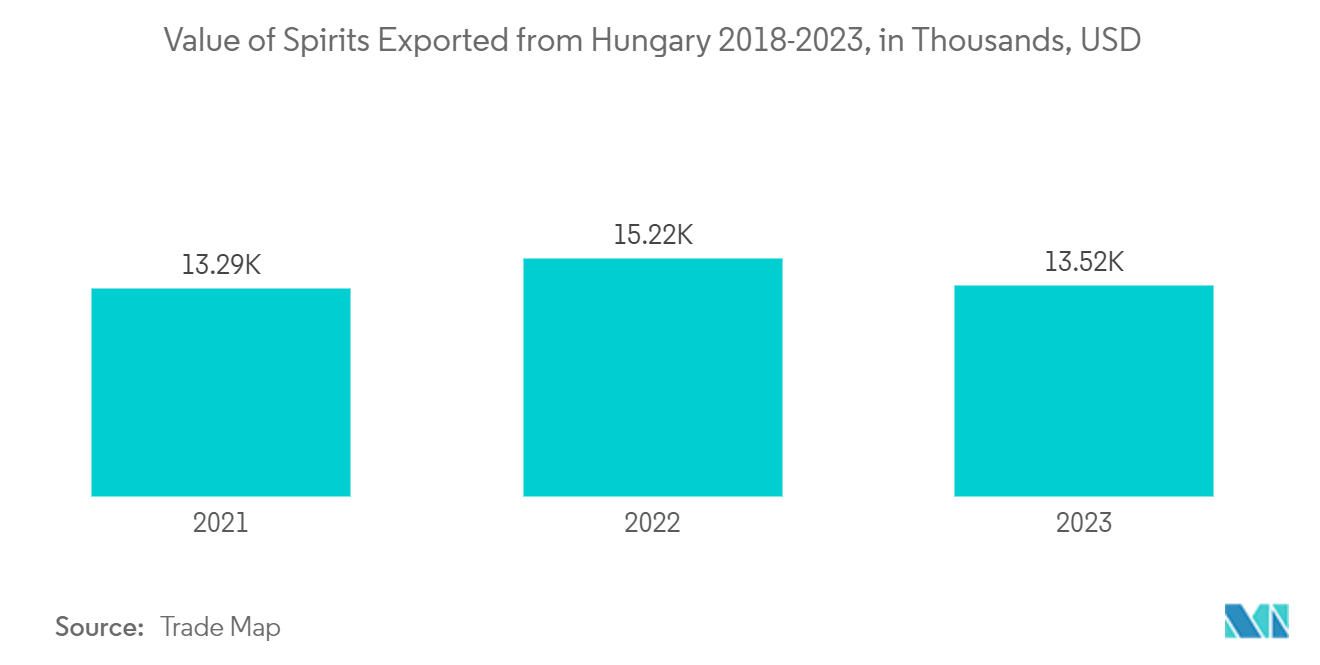Market Trends of Glass Bottles And Containers Industry
Wine and Spirits to Lead the Non-alcoholic Beverages Segment
- The glass bottle is most favored in wine packaging, especially colored glass, the reason being that wine should not be exposed to sunlight. Otherwise, it gets spoiled. The increasing consumption of wine is expected to spearhead the glass packaging demand during the forecasted period. Wine manufacturers are becoming increasingly innovative to attract customers with the packaging and are developing new concepts and designs. For example, Vinebox ships customers a box of nine single-serve wines packaged in cylindrical 100 ml glass containers four times a year.
- The wine packed in glass bottles offers a premium experience through the design, elegant feel, and heritage. The unique design provides the feeling of luxury that other packaging materials could not offer. Wine is also used for gifting purposes on occasions in the developed country. Therefore, the wine packed in unique glass bottles gains an advantage over the other packaging solutions.
- The brands and packaging manufacturers focus on developing lightweight glass bottles to reduce carbon footprints. In addition, the brands and companies are also carrying out experiments and studies to develop lightweight bottles for sparkling wine called champagne. French glassmaker Verallia Group and Champagne Telmont announced the success of their most recent experiment of using an 800-gram champagne glass bottle in 2023. The new lighter glass bottles will generate around 4% less carbon dioxide per bottle produced.
- The United States, France, Italy, Germany, and the United Kingdom are the top five countries in terms of wine consumption. According to the International Organization of Vine and Wine, wine consumption in the United States increased by 2.8% in 2022 compared to 2021. Furthermore, bottled wine represented the major portion of the trade volume globally, accounting for 53% in terms of trade volume and 68% in terms of trade value for the year 2022. The bottled wine trade value increased by 7% in 2022 compared to 2021. Bottled wine exports were high in most countries compared to other packaging types. For instance, Italy exported 57% of wine in bottles, France 72%, Chile 58%, Germany 73%, Portugal 76%, the United States 52%, Argentina 76%, Australia 35%, and Spain 34%.
- The increasing consumption and trade of spirits worldwide are driving the demand for glass bottles for spirits. The United States is the second-largest market for spirits in the world, according to the Distilled Spirits Council of the United States. The spirits export in the United States nearly quadrupled over the past two decades, reaching around USD 2.1 billion in 2022 from USD 551 million in 2022. The export of whiskey in the United States stood at around 23.3 million gallons from January to June 2023. Out of the total whiskey exports, bottled whiskey accounts for around 55.44% of the total. This showcases a fair impact on the market.

Asia-Pacific to Hold the Largest Market Share
- The packaging industry in China is growing at a fast and steady rate due to the country's expanding economy and growing middle class with more purchasing power. The need for beverage packaging is increasing because China's beverage market has grown significantly recently.
- Each beverage category will have challenges and opportunities, but new trends in the Chinese consumer lifestyle are shaping the demand for glass packaging. China has seen a rise in the consumption of alcoholic and non-alcoholic drinks across all industries in its large urban centers. Some of the most preferred beverages by millionaires in China are Red Wine, Whiskey, and Champagne.
- The increase in the consumption of alcoholic beverages in India is expected to support the growth of glass bottles and containers. The glass bottle is most favored in alcoholic beverages, wildly colored glass for wine because wine gets spoiled if exposed to the sunlight. Also, the increasing consumption of wine is expected to spearhead the glass packaging demand during the forecasted period. For Example, according to Agriculture and Agri-Food Canada, the volume of wine consumption across India is projected to reach 52.2 million liters in 2025.
- Moreover, the demand for the market will also be impacted by the growth in non-alcoholic beverages. Soft drinks are the most significant pillar on which the business of non-alcoholic drinks rests. Glass bottles retain a 35% share of sales for Coke in India. In May 2022, Coca-Cola India Pvt. Ltd started promoting returnable glass bottles again in select states across the company's top-selling brands, such as Coca-Cola, Thums Up, and Sprite. In some markets, glass bottles comprise 30% of beverage sales in 2022.
- The growth in domestic beer during the past years is expected to support growth in glass packaging. The retail sales of beer in South Korea reached USD 19.27 billion in 2022 from USD 15.98 billion in 2018. The market has experienced growth in the past years and is anticipated to show similar signs of change in the years ahead (Agriculture and Agri-Food Canada).
- Apart from the countries already discussed in the study under the Asia-Pacific region, other countries like Australia, Taiwan, Thailand, Malaysia, Singapore, Vietnam, etc., also have a high potential scope for gaining a considerable share in the market studied. The growth in the sale of alcoholic beverages, acquisitions, and mergers drives the market for glass packaging in the region.


